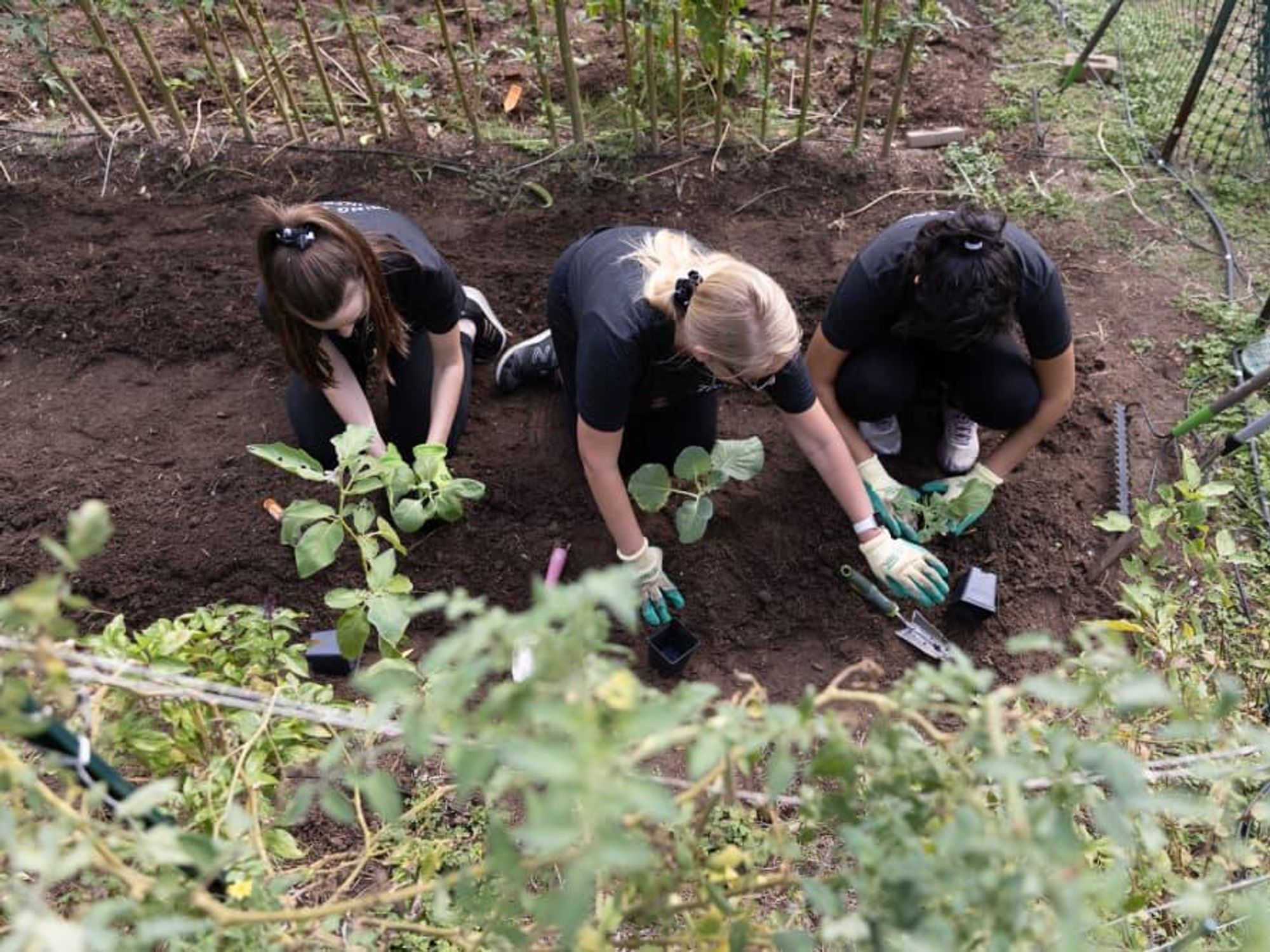Heart and soil
Austin’s homegrown vodka brand spruces up community gardens in the Capital City and beyond

One overcast Wednesday this October in North Austin, a small team worked quietly in the garden outside the YMCA. The volunteers toiled on behalf of Love, Tito’s, the philanthropic outreach branch of Austin’s own Tito’s Handmade Vodka.
For this stop on its nationwide community gardening project, Block to Block, Tito’s teamed up with the Austin Parks Foundation. By the late morning, all the volunteers knew their tasks, and were wordlessly turning over soil, handing off boards to each other, and surveying next steps.
The community garden at the North Austin YMCA already existed before Tito’s got there. The result of an arts initiative in 2012, the garden is still functional, but needed a lot of work to update and restart some of its basic functionality, more than the YMCA-run work day could achieve at once.
Some of the garden's 75 beds, wrapping around a central shed, are dedicated to YMCA members, who shoulder most of their maintenance and enjoy the fruits of it themselves. Others represent the YMCA and are used in teaching demonstrations. When the community beds bear vegetables, the YMCA leaves them out for visitors to take home.
“We’ve seen it become really popular during the pandemic,” says Lindsey Bates, program and communications manager for Love, Tito’s. “When a lot of people were stuck at home, it was a great way to get outside and be safe, be socially distanced, but also be part of a community and grow something with your own hands. We were talking to some of the gardeners here this morning. They said they really like to come out in the morning because it’s a really good way to start your day.”
The Tito’s team started with dilapidated and tired beds, tearing down wood planks that had succumbed to years of moisture and the strain of heavy soil, and nailing new ones back in place. The raised beds (like big window boxes on top of the lawn that hold entire small gardens) are more accessible to people who can’t or don’t want to dig hunched over in the compact ground. They also make it easy to separate work environments and isolate soil from the greater environment to keep it healthy.
The team also turned over soil that had been sitting too long — to aerate it and redistribute nutrients — and weeded overrun beds. They exposed the unintentionally hidden site by clearing growth from the surrounding wire fence along the road. That’s good news for neighbors who didn’t know the community garden exists. (Your friendly CultureMap reporter is one of them.)
At the same time, across town in South Austin, another Love, Tito’s team did similar work in the Heartwood Garden.
The City of Austin maintains 26 community gardens as part of its own program, and estimates they generate 100,000 pounds of produce every year. A map of all the sites from the City-supported Coalition of Austin Community Gardens shows that most Austinites live within roughly 2 miles of a garden.
Tito’s got involved in gardening when it built its own collaborative plot at its Austin distillery. The staff now gets healthy farm-to-table meals at work and can even take some produce home. Feeling the success, Tito’s took the show on the road with the Block to Block project. In 28 cities, including Austin (and San Antonio and Dallas), the program seeks nonprofit partners to offer support in creating and renovating community gardens. It also manages an ongoing relationship close to home with Austin Parks Foundation, lending volunteer help or sponsoring projects when it can’t offer hands in the soil.
Just as there is no shortage of community gardens to visit, there are plenty of opportunities to help maintain them, whether you rent a plot or garden hop as a volunteer. It’s My Park Day is a semiannual large-scale work day across Austin that prepares gardens, greenbelts, and other outdoor community spaces for the shifting seasons: one in fall, and one in spring. Texans are lucky among Americans to have an extended growing season, thanks to warmer temperatures. (We do pay for it in the summer; try a shade cloth if plants are melting in the sun.)
This year’s fall initiative takes place Saturday, November 6, and there’s still plenty of space for volunteers. According to pandemic guidance, each location caps out at 25 volunteers, but it’s unlikely every location will fill up. Some gardens looking for help with projects include the Lamplight Community Garden, the Cherry Creek Community Garden, and the Davis Elementary Memory Garden. Even when there is no citywide event, there is probably a monthly work day at a smaller farm close to every Austinite’s home.
Community garden program coordinator Jennifer Steverson of the City of Austin’s Parks and Recreation Department offers some advice between heroically shovelling and wiping her brow. All Austin community gardens need to meet organic growing standards, so integrated pest management (sans pesticides) is a must. Intercropping, a system of growing different plants very close together, can solve that problem while using resources like water and space much more efficiently.
Consult the Texas A&M planting calendar for up-to-date advice on what to plant and when. Raised beds made with untreated wood are always a good choice for healthy soil. Finally, don’t work too hard. Gardens are made to be enjoyed.
“Every garden looks different based on who is gardening there,” Steverson says. Decorations are encouraged, and the sky, literally, is the limit. The same rules apply in the garden as anywhere else: It’s all good “as long as you’re not shading your neighbor.”
Sign up to help clean up Austin’s parks, trails, gardens, and greenbelts on It’s My Park Day Fall 2021, scheduled for November 6, at austinparks.org.

 Pilates is one of the many modalities on the schedule.Photo courtesy of Life Time
Pilates is one of the many modalities on the schedule.Photo courtesy of Life Time


 This giant sauna doubles as a social amenity.Photo courtesy of Life Time
This giant sauna doubles as a social amenity.Photo courtesy of Life Time The Life Time Lounge offers another place to hang out.Photo courtesy of Life Time
The Life Time Lounge offers another place to hang out.Photo courtesy of Life Time